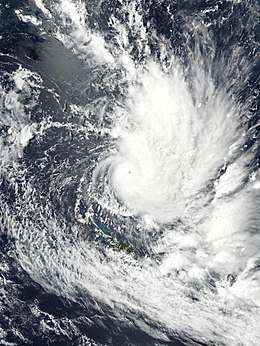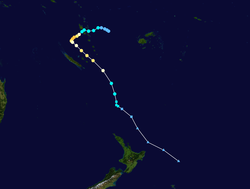Cyclone Hola
Severe Tropical Cyclone Hola was a strong tropical cyclone which affected Vanuatu, New Caledonia and New Zealand. Forming as a broad tropical disturbance on 5 March, the system slowly consolidated over the next few days before developing into a tropical cyclone on 6 March. Afterwards, a pinhole eye began to emerge and rapid intensification ensued.
| Category 4 severe tropical cyclone (Aus scale) | |
|---|---|
| Category 3 tropical cyclone (SSHWS) | |
 Cyclone Hola at peak intensity on 8 March | |
| Formed | March 3, 2018 |
| Dissipated | March 13, 2018 |
| (Extratropical after March 11) | |
| Highest winds | 10-minute sustained: 165 km/h (105 mph) 1-minute sustained: 185 km/h (115 mph) |
| Lowest pressure | 952 hPa (mbar); 28.11 inHg |
| Fatalities | 3 total |
| Damage | Unknown |
| Areas affected | Vanuatu, New Caledonia, New Zealand |
| Part of the 2017–18 South Pacific cyclone season | |
Meteorological history

During March 3, 2018 the Fiji Meteorological Service (FMS) reported that Tropical Disturbance 09F had developed within a trough of low pressure about 230 km (145 mi) to the northeast of Nadi, Fiji.[1][2] At this time the disturbance had a broad low-level circulation and was located within a very favourable environment for further development, with low vertical wind shear and warm sea surface temperatures.[3] Over the next couple of days, the disturbance gradually developed further as it gradually moved westwards towards Vanuatu, under the influence of a subtropical ridge of high pressure.[3][4] It was subsequently classified as a tropical depression by the FMS during March 5, before the United States Joint Typhoon Warning Center (JTWC) subsequently issued a tropical cyclone formation alert on the system later that day.[5][6]
During March 6, the JTWC initiated advisories on the system and designated it as Tropical Cyclone 12P, after its broad low-level circulation center had slowly consolidated and the overall organisation of the cyclone had improved.[7] The FMS subsequently reported that the system had developed into a Category 1 tropical cyclone on the Australian tropical cyclone intensity scale and named it Hola, while it was located about 80 km (50 mi) to the east of Pentecost Island in Vanuatu.[8] After it was named, Hola started developing a weak low level eye feature, before it was classified as a category 2 tropical cyclone as it passed in between the islands of Pentecost and Ambrym.[9][10] The system subsequently passed over the island of Malekula and moved into the Coral Sea during March 7, where it rapidly consolidated and developed a 10 km (5 mi) pinhole eye.[11][12] The FMS subsequently reported that Gita had become a Category 4 Severe Tropical Cyclone and predicted that Hola would peak as a Category 5 Severe Tropical Cyclone.[13] However, during the following day Hola's eye weakened and became cloud filled, as it stalled to the west of Vanuatu. As a result, the FMS reported that the system had peaked as a Category 4 Severe Tropical Cyclone with 10-minute sustained winds of 165 km/h (105 mph). During March 8, the JTWC also reported that Hola had peaked with 1-minute sustained winds of 185 km/h (115 mph), which made it equivalent to a Category 3 hurricane on the Saffir-Simpson Hurricane Wind Scale.[14]
Preparations and impact
Hola raged over Vanuatu as a Category 4 very severe tropical cyclone at 07:00am NZT, and killed one person and seriously injured another two as heavy rains and punishing winds lashed the region. Winds of up to 165 km/h (102 mph) and gusts of up to 230 km/h (143 mph) were reported. Multiple houses had suffered extensive damage and countless trees and crops had been uprooted. School classrooms were blown off their foundations in Ambrym but no injuries or deaths were reported. The school's principal claimed that 20 to 30 per cent of houses within the region would have been completely destroyed after feeling the full-force of Hola. Heavy rainfall, damaging winds and bursting river banks rattled the region. [15] [16]
See also
References
- "Heavy Rain and Flood Alerts in force" (PDF) (Press release). Fiji Meteorological Service. March 3, 2018. Archived (PDF) from the original on March 7, 2018. Retrieved March 7, 2018.
- "Tropical Disturbance Summary March 3, 2018 09z". Fiji Meteorological Service. March 3, 2018. Archived from the original on March 3, 2018. Retrieved March 7, 2018.
- "Significant Tropical Weather Advisory for the Western and South Pacific Oceans March 3, 2018 10z". United States Joint Typhoon Warning Center. March 3, 2018. Archived from the original on March 3, 2018. Retrieved March 8, 2018.
- "TD09F moving further away from the group" (PDF) (Press release). Fiji Meteorological Service. March 6, 2018. Archived (PDF) from the original on March 8, 2018. Retrieved March 8, 2018.
- "Tropical Disturbance Summary March 5, 2018 06z". Fiji Meteorological Service. March 5, 2018. Archived from the original on March 5, 2018. Retrieved March 7, 2018.
- "Tropical Cyclone Formation Alert March 5 2018 14z". United States Joint Typhoon Warning Center. March 5, 2018. Archived from the original on March 5, 2018. Retrieved March 8, 2018.
- "Tropical Cyclone 12P (Hola) Warning March 6, 2018 15z". United States Joint Typhoon Warning Center. March 6, 2018. Archived from the original on March 6, 2018. Retrieved March 8, 2018.
- "Tropical Disturbance Advisory March 6, 2018 12z". Fiji Meteorological Service. March 6, 2018. Archived from the original on March 6, 2018. Retrieved March 8, 2018.
- "Tropical Cyclone 12P (Hola) Warning March 6, 2018 21z". United States Joint Typhoon Warning Center. March 6, 2018. Archived from the original on March 7, 2018. Retrieved March 8, 2018.
- "Tropical Disturbance Advisory March 6, 2018 18z". Fiji Meteorological Service. March 6, 2018. Archived from the original on March 7, 2018. Retrieved March 8, 2018.
- "Tropical Disturbance Advisory March 7, 2018 00z". Fiji Meteorological Service. March 7, 2018. Archived from the original on March 7, 2018. Retrieved March 8, 2018.
- "Tropical Cyclone 12P (Hola) Warning March 7, 2018 15z". United States Joint Typhoon Warning Center. March 7, 2018. Archived from the original on March 7, 2018. Retrieved March 8, 2018.
- "Strengthened Tropical Cyclone Hola batters Vanuatu, likely to hit New Zealand". Stuff. March 8, 2018. Retrieved March 13, 2018.
- https://blog.metservice.com/node/1179
- https://www.aljazeera.com/news/2018/03/tropical-cyclone-hola-sets-sights-zealand-180311083055309.html
- https://www.stuff.co.nz/world/south-pacific/102041257/tropical-cyclone-hola-develops-near-vanuatu-impact-on-new-zealand-uncertain
External links
| Wikimedia Commons has media related to Cyclone Hola. |
- World Meteorological Organization
- Australian Bureau of Meteorology
- Fiji Meteorological Service
- New Zealand MetService
- Joint Typhoon Warning Center
